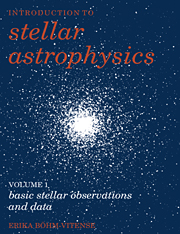Book contents
- Frontmatter
- Contents
- Preface
- 1 Positions of stars
- 2 Proper motions of stars
- 3 Distances of nearby stars
- 4 The brightnesses of the stars
- 5 Color magnitude diagrams
- 6 The luminosities of the stars
- 7 Angular radii of stars
- 8 Effective temperatures of stars
- 9 Masses and radii of stars
- 10 Spectral classification
- 11 Understanding stellar spectra
- 12 Population II stars
- 13 Stellar rotation
- 14 Stellar magnetic fields
- 15 Stars with peculiar spectra
- 16 Pulsating stars
- 17 Explosive stars
- 18 Our sun
- 19 Interstellar absorption
- Appendixes
- References
- Index
- Frontmatter
- Contents
- Preface
- 1 Positions of stars
- 2 Proper motions of stars
- 3 Distances of nearby stars
- 4 The brightnesses of the stars
- 5 Color magnitude diagrams
- 6 The luminosities of the stars
- 7 Angular radii of stars
- 8 Effective temperatures of stars
- 9 Masses and radii of stars
- 10 Spectral classification
- 11 Understanding stellar spectra
- 12 Population II stars
- 13 Stellar rotation
- 14 Stellar magnetic fields
- 15 Stars with peculiar spectra
- 16 Pulsating stars
- 17 Explosive stars
- 18 Our sun
- 19 Interstellar absorption
- Appendixes
- References
- Index
Summary
The topic of this volume is stellar astronomy or more accurately stellar astrophysics. We call it astrophysics because all our knowledge about stars is based on the application of the laws of physics to the stars. We want to find out how big the stars are, how much mass they have, what material they are made of, how hot they are, how they evolve in time, and how they are distributed in space. The last question does not strictly belong to the field of stellar astrophysics but knowledge of stellar structure and evolution will provide a means by which to determine their distances. There are also important correlations, for instance, between the location and motion of the stars in our Galaxy and their physical properties.
In Volume 1, we shall be concerned mainly with finding out about the global properties of stars, such as brightnesses, colors, masses and radii. Brightnesses and colors can be measured directly for all stars, for masses and radii we have to study binaries. Parallax measurements can give us distances to nearby stars. We shall first discuss the majority of stars which we call normal stars. In the latter parts of this volume we shall also look at stars which seem to be different, the so-called ‘peculiar’ stars.
How can we get information, for instance, about the physical properties of the stars such as their temperatures, pressures, and chemical compositions?
- Type
- Chapter
- Information
- Introduction to Stellar Astrophysics , pp. ix - xPublisher: Cambridge University PressPrint publication year: 1989

